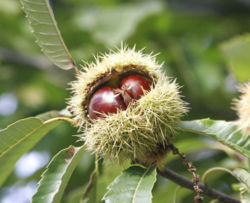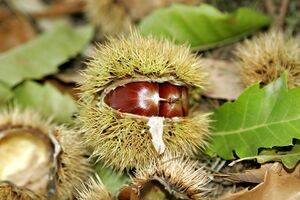Sweet Chestnut: Difference between revisions
m Reverted edits by 213.203.197.115 (Talk); changed back to last version by Raffi |
trletotr |
||
| Line 1: | Line 1: | ||
montaviv | |||
{{Taxobox | {{Taxobox | ||
| color = lightgreen | | color = lightgreen | ||
| Line 40: | Line 41: | ||
Image:Sweet chestnut DSCF0160.JPG|Retiform bark | Image:Sweet chestnut DSCF0160.JPG|Retiform bark | ||
Image:Ancient coppice of a sweet chestnut DSCF0322.JPG|Ancient Sweet Chestnut coppice, Banstead Woods, Surrey, UK | Image:Ancient coppice of a sweet chestnut DSCF0322.JPG|Ancient Sweet Chestnut coppice, Banstead Woods, Surrey, UK | ||
Image:Illustration Castanea sativa0.jpg|Sweet Chestnut, from | Image:Illustration Castanea sativa0.jpg|Sweet Chestnut, from Thomé, ''Flora von Deutschland, Ãsterreich und der Schweiz'', 1885 | ||
</gallery> | </gallery> | ||
Revision as of 19:06, 3 January 2009
montaviv
| Sweet Chestnut {{{status}}} Fossil range: {{{fossil_range}}}
| ||||||||||||||||||||||||||||||||||||||||||||||||||||||||||||||||||
|---|---|---|---|---|---|---|---|---|---|---|---|---|---|---|---|---|---|---|---|---|---|---|---|---|---|---|---|---|---|---|---|---|---|---|---|---|---|---|---|---|---|---|---|---|---|---|---|---|---|---|---|---|---|---|---|---|---|---|---|---|---|---|---|---|---|---|
 Sweet Chestnut fruit | ||||||||||||||||||||||||||||||||||||||||||||||||||||||||||||||||||
| Plant Info | ||||||||||||||||||||||||||||||||||||||||||||||||||||||||||||||||||
| ||||||||||||||||||||||||||||||||||||||||||||||||||||||||||||||||||
| Scientific classification | ||||||||||||||||||||||||||||||||||||||||||||||||||||||||||||||||||
| ||||||||||||||||||||||||||||||||||||||||||||||||||||||||||||||||||
| [[{{{diversity_link}}}|Diversity]] | ||||||||||||||||||||||||||||||||||||||||||||||||||||||||||||||||||
| {{{diversity}}} | ||||||||||||||||||||||||||||||||||||||||||||||||||||||||||||||||||
| Binomial name | ||||||||||||||||||||||||||||||||||||||||||||||||||||||||||||||||||
| Castanea sativa Mill. | ||||||||||||||||||||||||||||||||||||||||||||||||||||||||||||||||||
| Trinomial name | ||||||||||||||||||||||||||||||||||||||||||||||||||||||||||||||||||
| {{{trinomial}}} | ||||||||||||||||||||||||||||||||||||||||||||||||||||||||||||||||||
| Type Species | ||||||||||||||||||||||||||||||||||||||||||||||||||||||||||||||||||
| {{{type_species}}} | ||||||||||||||||||||||||||||||||||||||||||||||||||||||||||||||||||
| {{{subdivision_ranks}}} | ||||||||||||||||||||||||||||||||||||||||||||||||||||||||||||||||||
| [[Image:{{{range_map}}}|{{{range_map_width}}}|]] | ||||||||||||||||||||||||||||||||||||||||||||||||||||||||||||||||||
| Synonyms | ||||||||||||||||||||||||||||||||||||||||||||||||||||||||||||||||||
| {{{synonyms}}} |
The Sweet Chestnut (Castanea sativa, family Fagaceae), also known as the Spanish Chestnut, is a species of chestnut native to southeastern Europe and Asia Minor. It is a medium-sized to large deciduous tree attaining a height of 20-35 m with a trunk often 2 m in diameter. The oblong-lanceolate, boldly toothed leaves are 16-28 cm long and 5-9 cm broad.
The flowers of both sexes are borne in 10-20 cm long, upright catkins, the male flowers in the upper part and female flowers in the lower part. They appear in late June to July, and by autumn, the female flowers develop into spiny cupules containing 3-7 brownish nuts that are shed during October.
The bark often has a net-shaped (retiform) pattern with deep furrows or fissures running spirally in both directions up the trunk.
The tree requires a mild climate and adequate moisture for good growth and a good nut harvest. It is sensitive to late spring and early autumn frosts, and is intolerant of lime. Under forest conditions it will tolerate moderate shade well.

Uses
Sweet Chestnut is widely cultivated for its edible nuts. As early as Roman times it was introduced into more northerly regions, and later it was cultivated in monastery gardens by monks. Today, centuries-old specimens may be found in Great Britain and the whole of central and western Europe. The nuts are used by confectioners and are also eaten roasted. They are popular in France, Portugal, Italy and particularly in Corsica. They may be roasted whole or ground to make flour. The Corsican variety of polenta (called pulenta) is made with sweet chestnut flour. A local variety of Corsican beer also uses chesnuts.
The durable wood is used to make furniture, barrels (sometimes used to age balsamic vinegar), fencing and roof beams in houses of the Alpujarra, Spain; due to its tendency to split and warp badly, it is not used in large pieces. The bark also provides tannin.
Gallery
-
Sweet Chestnut tree
-
Middle Rhine Valley, Germany
-
Retiform bark
-
Ancient Sweet Chestnut coppice, Banstead Woods, Surrey, UK
-
Sweet Chestnut, from Thomé, Flora von Deutschland, Ãsterreich und der Schweiz, 1885
References
- Flora Europaea: Castanea sativa
- Rushforth, K. (1999). Trees of Britain and Europe. HarperCollins ISBN 0-00-220013-9.







